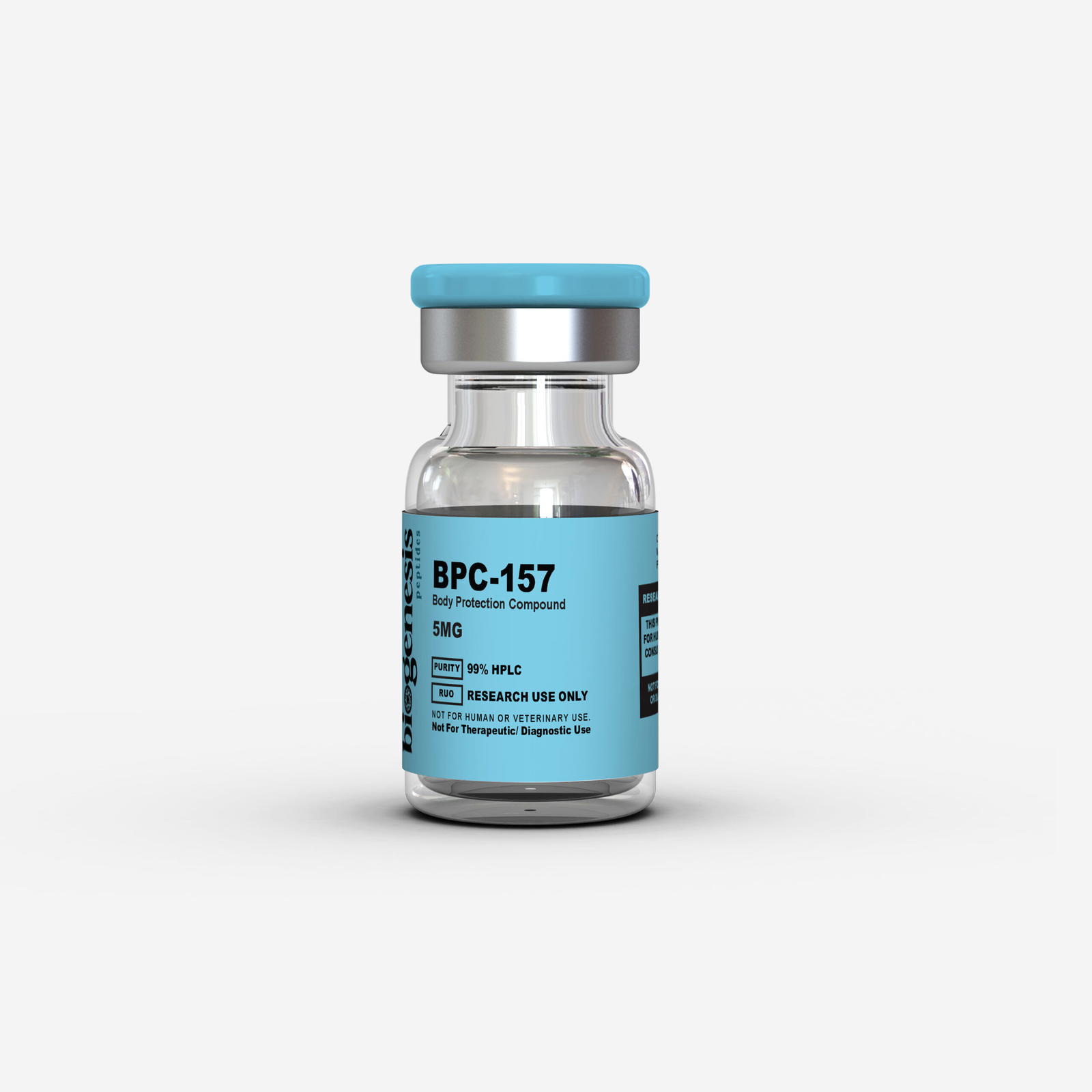Product Usage
THIS PRODUCT IS INTENDED AS A RESEARCH CHEMICAL ONLY. This designation allows the use of research chemicals strictly for in vitro testing and laboratory experimentation only. All product information available on this website is for educational purposes only. Bodily introduction of any kind into humans or animals is strictly forbidden by law. This product should only be handled by licensed, qualified professionals. This product is not a drug, food, or cosmetic and may not be misbranded, misused, or mislabeled as a drug, food, or cosmetic.
BPC-157 5mg
BPC-157, short for Body Protection Compound 157, is a synthetic peptide consisting of 15 amino acids. It originates from a protective protein found in human gastric juice and has been extensively researched for its healing and regenerative properties.
$49.00
Peptides will arrive in a lyophilized (powder) form for maximum stability
Out of stock
Buy 5 for 5% off
Buy 10 for 10% off
Buy 15 for 15% off
BPC-157, short for Body Protection Compound 157, is a synthetic peptide consisting of 15 amino acids. It originates from a protective protein found in human gastric juice and has been extensively researched for its healing and regenerative properties.
Key Benefits of BPC-157:
- Tissue Regeneration: Supports healing in muscles, tendons, ligaments, and the gastrointestinal (GI) tract.
- Anti-Inflammatory Effects: Reduces inflammation in multiple tissues.
- Organ Protection: Demonstrates protective effects on the stomach lining, liver, and nervous system.
- Wound Healing Acceleration: Promotes angiogenesis (new blood vessel formation) and boosts collagen production.
- Neurological Support: Animal studies suggest potential nerve regeneration and brain healing.
Due to these properties, BPC-157 is being explored for its potential in treating injuries, chronic conditions, and inflammatory diseases.
RESEARCH
BPC-157 and Wound Healing
BPC-157 plays a natural role in the gastrointestinal tract, maintaining the mucosal barrier to protect tissues from gastric acid, bile, and harmful substances. Research suggests that it enhances:
- Fibroblast activity, speeding up wound repair.
- Extracellular matrix production, increasing collagen, fibrin, and elastin synthesis.
- Rapid migration of healing cells to damaged areas.
Blood Vessel Growth and Circulatory Benefits
BPC-157 has been identified as a strong angiogenic factor, meaning it enhances blood vessel formation:
- Studies in rats suggest that BPC-157 stimulates new blood vessel growth, which may help in stroke recovery, heart attack recovery, and tissue repair.
- Research in chicken embryos shows that it interacts with VEGFR2, a key receptor in nitric oxide signaling, to promote vascularization.
BPC-157 and Tendon/Connective Tissue Repair
Animal research suggests that BPC-157 significantly enhances the healing of tendons, ligaments, bones, and connective tissues:
- Found to be more effective than commonly known growth factors such as bFGF, EGF, and VEGF in tendon and ligament healing.
- Encourages fibroblast proliferation and new blood vessel formation in injured connective tissue.
Antioxidant and Protective Effects
Studies in rats indicate that BPC-157 may:
- Reduce oxidative stress markers such as nitric oxide and malondialdehyde (MDA).
- Protect against reactive oxygen species (ROS) accumulation, particularly in the GI tract.
BPC-157 and Medication-Induced Damage
Research suggests that BPC-157 may help counteract the harmful effects of certain medications:
- Protects against NSAID-induced gastric damage, reducing the risk of ulcers from common painkillers.
- May lessen side effects of psychiatric drugs, including QTc prolongation, a risk factor for heart arrhythmias.
- Has shown potential in preventing organ toxicity caused by various medications.
BPC-157 and Neurological Healing
Studies indicate that BPC-157 may contribute to brain and nerve regeneration:
- Animal models suggest enhanced cognitive function and neuroprotection in cases of traumatic brain injury (TBI).
STRUCTURE
- Molecular Formula: C₆₂H₉₈N₁₆O₂₂
- Molecular Weight: 1419.56 g/mol
- Amino Acid Sequence: Gly-Glu-Pro-Pro-Pro-Gly-Lys-Pro-Ala-Asp-Asp-Ala-Gly-Leu-Val
- CAS Registry Number: 137525-51-0
- PubChem Identifier: 108101
CITATIONS
- Huang T. et al. Body Protective Compound-157 enhances alkali-burn wound healing in vivo. Drug Design, Development, and Therapy (2015).
- Drmic D. et al. Counteraction of perforated cecum lesions in rats. World Journal of Gastroenterology (2018).
- Amic F. et al. Bypassing major venous occlusion and duodenal lesions in rats with BPC-157. World Journal of Gastroenterology (2018).
- Duzel A. et al. Stable gastric pentadecapeptide BPC-157 in the treatment of colitis. World Journal of Gastroenterology (2017).
- Vukojević J. et al. BPC-157 and vascular repair mechanisms. Vascular Pharmacology (2020).
- Chang C-H. et al. The promoting effect of BPC-157 on tendon healing. Journal of Applied Physiology (2010).
- Kim J. & Jung Y. Potential role of Thymosin Beta-4 in liver fibrosis. International Journal of Molecular Sciences (2015).
- Song R. et al. Association between serum thymosin β4 levels and rheumatoid arthritis disease activity. Clinical Rheumatology (2012).
- Philp D. et al. Thymosin β4 promotes angiogenesis and wound healing. Mechanisms of Ageing and Development (2004).
All products on this site are for Research, Development use only. Products are Not for Human consumption of any kind.
The statements made within this website have not been evaluated by the US Food and Drug Administration. The statements and the products of this company are not intended to diagnose, treat, cure or prevent any disease.
Biogenesis Peptides is a chemical supplier. Biogenesis Peptides is not a compounding pharmacy or chemical compounding facility as defined under 503A of the Federal Food, Drug, and Cosmetic act. Biogenesis Peptides is not an outsourcing facility as defined under 503B of the Federal Food, Drug, and Cosmetic act.

